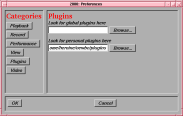Supports the most soundcards and resolves most audio problems by
itself. Another advantage of the commercial driver is that you can
start playing from the timeline after a recording is already in
progress. Only supports 64k output buffers and 128k input buffers on
the SB16.
To get full duplex on a SB16 using the commercial OSS driver:
Go to Settings->Preferences->Record.
Set the Record device to /dev/dsp 16 bits 2 channels.
Set the Duplex device to /dev/dsp 8 bits 2 channels.
Notice the settings must be different for both devices.
64k buffers by default, but the sourcecode can be hacked to give 128k
buffers for both input and output. Virtually no compatibility with
current soundcards. Full duplex is only possible by starting
playback and record simultaneously, in the record window.
To get full duplex on a SB16 using the free OSS driver:
Go to Settings->Preferences->Record.
Set the Record device to /dev/dsp 16 bits 2 channels.
Set the Duplex device to /dev/dsp 16 bits 2 channels.
Notice the settings must be identical for both devices unless you
really have two soundcards.
You'll want to hack your 2.2 kernel to get the 128k DMA size.
Go to /usr/src/linux/drivers/sound/sound_config.h
Change
#define DSP_BUFFSIZE (64*1024)
to
#define DSP_BUFFSIZE (128*1024)
Next go to /usr/src/linux/drivers/sound/dmabuf.c
Change
dma_pagesize = (dmap->dma < 4) ? (64 * 1024) : (128 * 1024);
to
dma_pagesize = (dmap->dma < 4) ? (128 * 1024) : (128 * 1024);
Recompile, reinstall your kernel modules and reload the sound driver.
 Go to settings->preferences->plugins. Set the personal plugin
directory to where all the *.plugin files are. This would normally be
bcast2000/plugins. Reboot Broadcast 2000.
Go to settings->preferences->plugins. Set the personal plugin
directory to where all the *.plugin files are. This would normally be
bcast2000/plugins. Reboot Broadcast 2000.
 When you first boot up, you'll get a Broadcast 2000 window, Console,
Levels, and Video window. Feel free to close every window but the
Broadcast 2000 window to free up space.
When you first boot up, you'll get a Broadcast 2000 window, Console,
Levels, and Video window. Feel free to close every window but the
Broadcast 2000 window to free up space.